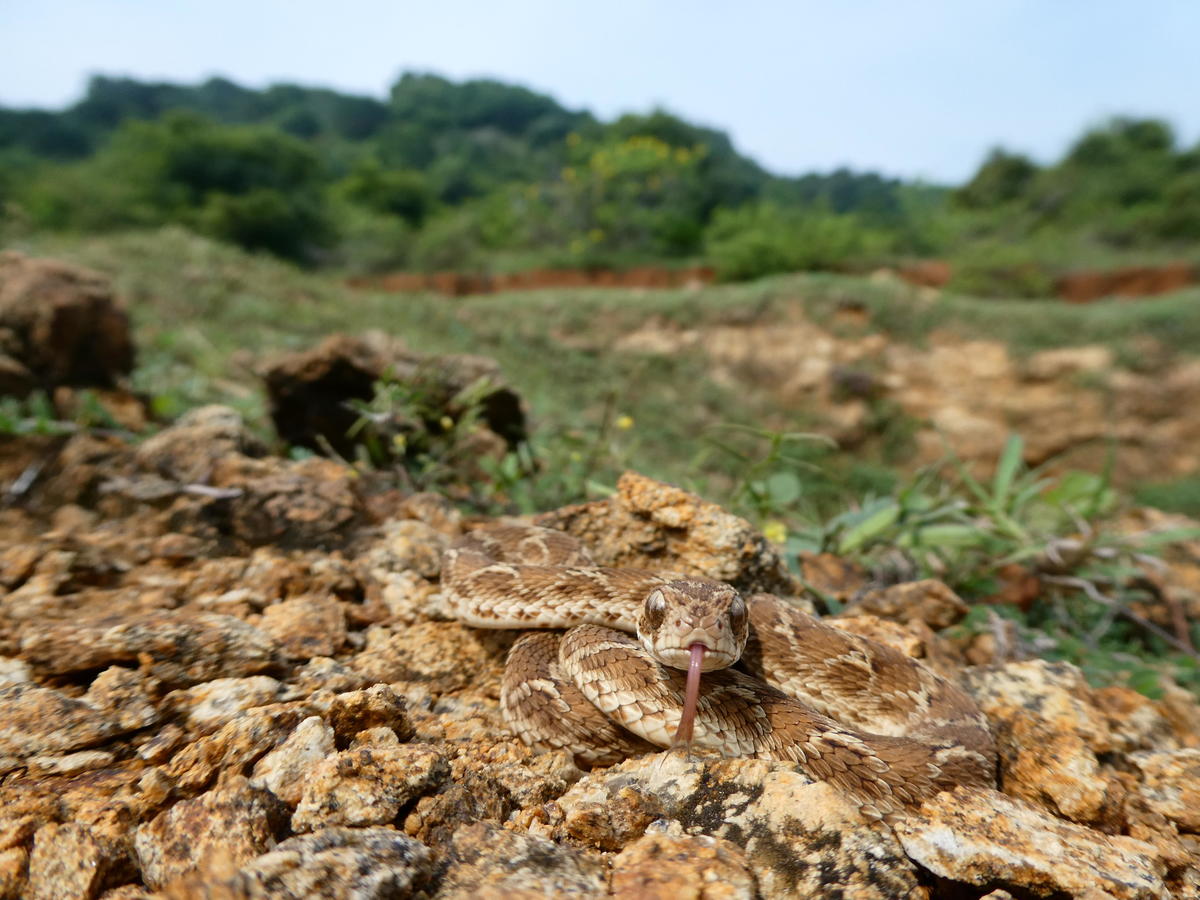CSRI has been heavily involved in undertaking and publishing research on the development, testing and delivery of snakebite therapies known as antivenoms. These antibody-based therapeutics are the cornerstone of snakebite treatment, although their method of production has changed little over the past century.
Antivenoms are manufactured by immunising horses or sheep with non-toxic amounts of venom. The venom-immunised animals mount an immune response to the venom toxins, producing anti-toxin antibodies – the active ingredient of antivenoms. Repeated immunisation, so called “hyper-immunisation”, results in high concentrations of anti-toxin antibodies in the blood of the animals. The antibodies are harmlessly extracted from the blood of the animal and processed into antivenom ready to be delivered into patients.
Broadly there are two types of antivenom – monospecific and polyspecific. Monospecific antivenoms are made with the venom of a single species of snake, while polyspecific antivenoms are made using venom of many different snakes. Polyspecific antivenoms are useful in regions like sub-Saharan Africa due to the large diversity of venomous snakes.
However, polyspecific antivenoms are often less-potent that monospecific antivenoms, due to having antibodies to many different venoms, and require many more doses to neutralise the effect of envenoming by any one species. This further increases the risks of adverse reactions and the cost of treatment for typically already impoverished snakebite victims.
The focus of our therapeutic research is to overcome the various factors causing poor polyspecific antivenom potency. We are doing this by applying cutting edge-technological approaches to engineer antivenoms which will have increased potency, safety and affordability, whilst maintaining and increasing the multi-species effectiveness of current polyspecific antivenoms.
Toxin-Specific Antivenoms
Through genetic engineering, we are currently pioneering the development of toxin-specific antivenoms to treat envenoming by multiple snake species. By characterising at the molecular level the toxins present in multiple snake species’ venoms, we can identify which venom proteins are responsible for causing the pathology seen during snakebite and identify those that are common in all venoms. We can then investigate these identified toxins in further detail, and identify regions that are cross-species conserved (the same in all) and are likely to drive an immune response resulting in an antibody with neutralising ability. By synthetically engineering and producing these toxin fragments as proteins, we can then use them as immunogens to immunise antivenom manufacturing animals. The resulting antibodies produced by the animal are thus specific only to the toxins that cause pathology in the venoms of many different species. We hope the improved, targeted and rational nature of these toxin-specific experimental antivenoms will improve antivenom effectiveness, whilst reducing cost and the risk of adverse reactions in patients.
Geographical Antivenoms
A key reason that antivenoms are unaffordable to the impoverished people of the tropics is that current antivenoms are specific to treating snakebite by relatively few snake species, and therefore sales and profit for the antivenom manufacturer are low. Producing a single antivenom for use in an entire geographical region should provide economies of scale to make antivenom manufacturing more amenable to private pharmaceutical companies. To achieve this, we are using “antivenomic” approaches to improve the geographical cover of existing antivenoms. By first using proteomic technologies to identify which snake venom toxins are not neutralised by an existing antivenom, we can then isolate those toxins and further supplement these to the immunising mixture to improve immune responses. By doing so, the new version of the antivenom should show greater efficacy to additional snake species found in the region of interest. We are currently using this approach to develop a new antivenom for the whole of sub-Saharan Africa.
Monoclonal Antibody-Based Antivenoms
The Scientific Research partnership for Neglected Tropical Snakebite (SRPNTS) programme aims to discover and pre-clinically validate the venom-neutralizing efficacy of a series of toxin-specific human/humanized monoclonal antibodies (HmAbs) as next-generation snakebite therapies (NGSTs). The expected outcomes and long-term impact of this work for disadvantaged tropical snakebite victims will be increased availability and uptake of effective, affordable and accessible snakebite therapies with universal (or continent-wide) efficacy against multiple snakes, especially in LMICs
Antivenom for Treating Local Tissue Pathology

Envenoming by many snakes causes extensive tissue death (necrosis). Antivenom is administered intravenously to treat systemic envenoming but antibodies are too large (~150 kDa) to rapidly cross the blood/tissue barrier to neutralise the venom toxins responsible for causing necrosis. Surgical debridement or amputation of the affected tissue is therefore performed to prevent spread of life-threatening gangrene. This problem is so commonplace that 8,000 amputations are performed on snakebite victims every year in Africa alone. We were the first to demonstrate that the uniquely small parts of camelid antibodies (IgG VHH) provide the most dose-effective immunotherapy ever developed against the local tissue-destructive and systemic effects of snake venom. The research challenge is to modify this novel experimental result into a venom-necrosis therapy for Africa that is affordable, stable at room temperatures and easily applied as an immediate First Aid tool.
Small Molecule Toxin inhibitors
We are currently researching the use of small molecule-based toxin inhibitors as rapid pre-hospital interventions to reduce the severity of snakebite envenoming. In the long term, we hope that this research will meet the need for effective, rapid, safe and affordable field-based interventions for snakebite. Using a repurposed medicines approach, we have investigated the potential utility of licensed drugs approved for use in other conditions and those that have been demonstrated to be safe in human clinical trials, as potential snakebite treatments. These studies have demonstrated the exciting potential utility of the oral licensed metal chelator DMPS against haemotoxic saw-scaled viper venoms, and that combinations of small molecule toxin inhibitors against different venom toxin classes provide geographically-wide neutralisation of venom lethality against haemotoxic snakes from Africa, Asia and Central America. While these early lead candidates continue to progress down the translational pathway, we are simultaneously applying in-house high throughput screening (HTS) assays for the discovery of novel toxin inhibitors via a traditional drug discovery route, and in collaboration with our commercial partners.